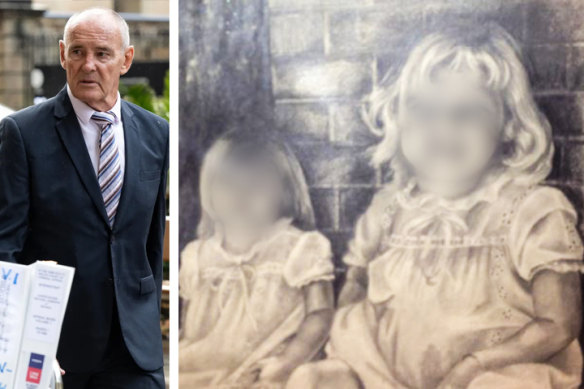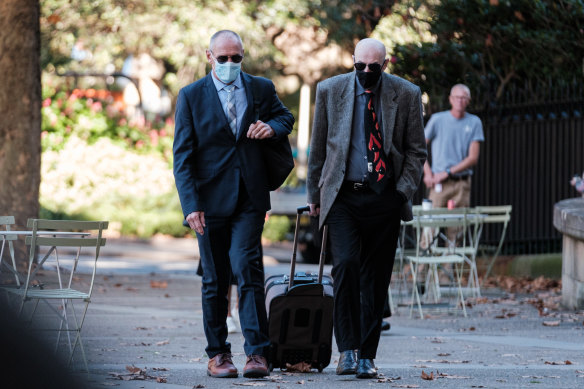This was published 1 year ago
Chris Dawson’s alleged ‘odd behaviour’ over children’s portraits
A top prosecutor has told Chris Dawson’s murder appeal that the convicted wife killer appeared to show a “complete lack of sentiment” towards his young daughters when he refused to look at portraits of the pair commissioned by his wife.
Dawson, 75, is appealing against his conviction for the murder of his wife, Lynette Joy Simms, who vanished from Sydney’s northern beaches in January 1982. The 33-year-old’s body has never been found.

Chris Dawson in 2022; and sketches of his daughters commissioned by his wife, Lynette, in 1981 and completed in 1982.Credit: Nick Moir, NSW Supreme Court
The three-day hearing concluded on Wednesday and the NSW Court of Criminal Appeal will deliver its decision at a later date.
Deputy Senior Crown Prosecutor Brett Hatfield, SC, urged the court to dismiss the appeal and drew the judges’ attention to evidence at Dawson’s 2022 trial that a local artist, Kristin Hardiman, had been commissioned by Lynette in December 1981 to produce sketches of the couple’s daughters.
Hardiman said in a statement in 2013 that she had called the Dawson residence about the completed sketches in mid-January 1982, and Dawson told her that “Lynette has gone away and she doesn’t want them any more”.
In 2022, she told the court that she had asked Dawson if he wanted to see the drawings “because they were of his children, and he said ‘no’.”
“I remember it very clearly because it was so odd,” Hardiman said.
Hatfield submitted on Wednesday that “it certainly was odd behaviour, one might think, not only the reaction of [Dawson] for the complete lack of sentiment towards his own children but a complete lack of regard for the young artist”. The couple’s daughters were aged 2 and 4 at the time of Lynette’s disappearance.
“Your honours might think ... [it displays] a desire just to want to quickly shut down any matter relating to his wife at that time. That’s just mid-January,” he said.
The court has heard Dawson claimed his wife had made a long-distance call to him on January 9 that year to tell him she needed “time away”, and made two further calls that month.
Court of Appeal President Julie Ward, who heard the appeal with Justices Anthony Payne and Christine Adamson, said: “What seems to me to be odd is how he knows that she doesn’t want [the sketches] any more.”
“Yes,” Hatfield said.
“This is at a stage where he’s telling people he thinks she’s coming back,” Ward said.
Hatfield submitted on Tuesday that “there is not a significant possibility that an innocent person has been convicted in this case”.
Evidence of elder brother
Hatfield also took the court to evidence given at the trial by Dawson’s elder brother, Peter.

Chris Dawson (left) outside the NSW Supreme Court in 2022 with his brother, Peter.Credit: Oscar Colman
“[Peter] was asked, ‘What did your brother Chris say to you about the whereabouts of his first wife, Lynette?’” Hatfield said.
Hatfield told the court that Peter Dawson replied: “I don’t remember any specific conversation with Chris about it. The general conversation was that Lyn had left.”
Asked during the trial what questions, if any, he had asked Chris about that, Peter Dawson replied: “I don’t remember asking him any questions about that.”
Hatfield said on Wednesday: “Incredible matter not to have a memory of, but that was his evidence on that point.”
During his brother’s trial, Peter Dawson had said of Lynette’s disappearance: “Because of other factors, it struck me as not all that unusual.”
He said that this was because his first wife’s mother “had done exactly what’s described”, and claimed she had left her children and “never contacted them again”.
The verdict
In 2022, Supreme Court Justice Ian Harrison found that Dawson, a former teacher and rugby league player, killed Lynette on or about January 8, 1982. He sentenced Dawson to a maximum of 24 years in prison with a non-parole period of 18 years.
Harrison found Dawson killed Lynette “for the selfish and cynical purpose of eliminating the inconvenient obstruction she presented” to a new life with his former student and daughters’ babysitter, known as JC, who was then 17.
The appeal
Dawson’s legal team identified five grounds for appeal, including that Harrison’s verdict was “unreasonable and unable to be supported” because it was not open on the evidence to be satisfied of Dawson’s guilt.
Start the day with a summary of the day’s most important and interesting stories, analysis and insights. Sign up for our Morning Edition newsletter.